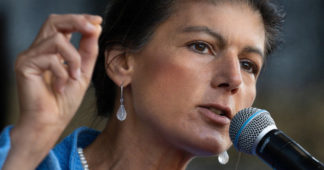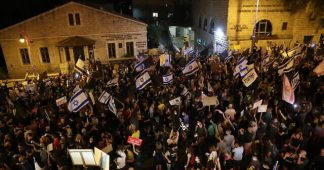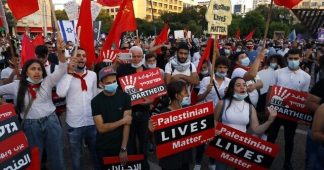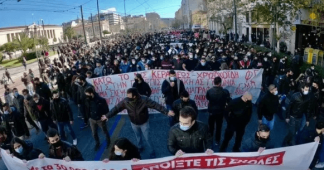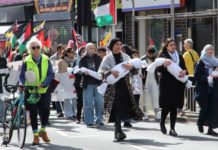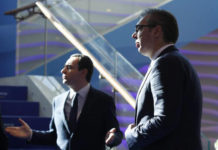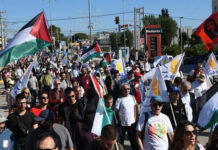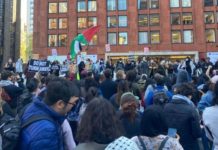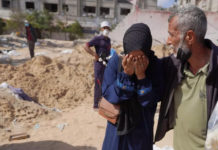At least 35,000 people at rally. Wagenknecht: “Starting to organize”. Participants confront right-wing freeriders
By Nico Popp
Correctly adjusted political glasses help to arrive at the respective required orders of magnitude when counting demonstration participants. The expertise of the Berlin police in this business is probably unrivaled in the Federal Republic of Germany. A demonstration for arms deliveries and a continuation of the war in Ukraine until a “victory” of Kiev, which had moved late Friday afternoon with about 7,000 people (including the party leadership of the Greens and SPD leader Saskia Esken) from Karl-Marx-Allee to the Brandenburg Gate, the Berlin police estimated upwardly deviating to 10,000 participants. For the much larger rally following the “Manifesto for Peace” signed by more than 600,000 people, which took place on Saturday afternoon and whose organizers Sahra Wagenknecht and Alice Schwarzer spoke out against a further “escalation of arms deliveries” and for diplomatic initiatives to end the war, the police named 13,000 participants. Once again, they clearly “overestimated” – this time, however, downwards.
The local police seemed to take note of the strong influx to the rally. Already around 2 p.m., they no longer allowed arriving participants to walk directly through the northern part of the Tiergarten to the site of the rally, but sent them on a detour via Yitzhak Rabin Street to the Straße des 17. A police officer deployed there justified this when asked that it was already “too crowded”. At this point, no more trains stopped at the Brandenburg Gate S-Bahn and U-Bahn station, citing overcrowding. Nevertheless, the Berlin police subsequently cited the conspicuously low number of 13,000 demonstrators, which would not have made it necessary to cordon off the access routes or close the station at all. By 2 p.m., the police said they had counted only 5,000 participants.
Police communication was also misleading in other respects: Citing the police, the news agency dpa, for example, spread the word that “a group of left-wing counter-demonstrators” had engaged in a “loud confrontation” with Jürgen Elsässer, publisher of the right-wing Compact magazine. If the impression was thus given that Elsässer had been confronted by “counter-demonstrators” as an accepted participant in the Wagenknecht-Schwarzer rally, in reality it was the case that Elsässer was, as it were, surrounded by anti-fascist participants in the said rally immediately after his appearance. The police evaded the request of the rally’s leadership to remove Elsässer.
According to the appearance on the spot, there were probably at least 35,000 people on Saturday, who had followed the call of the Member of the Bundestag Wagenknecht and the publicist Schwarzer in light snowfall and temperatures just above freezing point. The organizers named 50,000. About 30 people took part in a counter-rally from the spectrum of Ukrainian nationalists and their supporters on Ebertstraße opposite the U.S. Embassy, and about 10 in another on Pariser Platz.
The composition and appearance of Saturday’s rally was reminiscent from afar of the peace movement of the 1980s. Apart from a few flags of the party Die Linke, there were no party flags to be seen, but all the more symbols of the peace movement in all kinds of variations. The vast majority of participants had come without any flags or posters at all – an indication that Wagenknecht and Schwarzer had indeed succeeded in mobilizing a relatively broad base here. However, it must be assumed that the intensive efforts in the run-up to the rally to denounce it as a “cross-front” event ultimately kept many people away. Parts of Wagenknecht’s party, all the way up to the federal leadership, had also actively demobilized.
Wagenknecht said at the rally, to loud applause, that it was now possible to see “how many we are.” “We are now also starting to organize,” she announced. The country, she said, finally needs a strong peace movement again. Among parts of the political and media public, she said, “a real hysteria broke out” after the publication of the “Manifesto for Peace” – culminating in the attempt to place the initiators “close to the extreme right.” “Since when has the call for peace, the call for diplomacy and negotiations been on the right” and “war drunkenness on the left,” she asked in this context. Once again Wagenknecht emphasized that “neo-Nazis and Reich citizens” had no business at this peace rally; that goes without saying.
Politically, he said, the goal is to end the suffering and death in Ukraine. The alternative to offering Moscow negotiations, he said, is an “endless war of attrition.” Putin, too, must be prepared to negotiate and compromise. Ukraine must not become a “Russian protectorate,” he said. Further, he said, the growing danger of an expansion of the war and an escalation to nuclear war must be averted. Those who accept the danger of a nuclear inferno are “not on the right side of history,” he said. By name, Wagenknecht attacked Foreign Minister Annalena Baerbock, FDP member of parliament Marie-Agnes Strack-Zimmermann and Green Party member of parliament Anton Hofreiter. Many participants responded with “Baerbock must go” chants. Chancellor Scholz accused Wagenknecht of “regularly caving in to the war drummers.”
In her speech, Alice Schwarzer called it “absolutely right to stand by the Ukrainians, who have been brutally invaded by Russia, with weapons.” “After a year of death and devastation,” however, she said it was now right to “ask about the goal of this war and its proportionality.” She had learned a lot about tanks in the past year – from editors “who usually only know tanks from computer games.” What was missing from these reports were “the corpses.
Former Bundeswehr General Erich Vad called for “an end to war rhetoric in Germany,” an end to military escalation and the start of negotiations. He said that the war triggered by Russia in violation of international law had become a war of attrition in which there was no longer a “reasonable” military solution.
Schwarzer told dpa in the evening that it was a “tremendous success.” “It was such a peaceful and joyful mood. No party-linked mood, no sectarian mood. There were simply people from the middle of society who had traveled from all corners of Germany to set an example,” the publicist explained.
Junge Welt (jw) German Daily Online Extra
25.02.2023, 23:24:45 / Domestic
Peace Movement
Translated with www.DeepL.com/Translator (free version)
Also read
German lawmaker denounces Ukraine ‘proxy war’ and US ‘terrorist attack’ on Nord Stream pipelines
We remind our readers that publication of articles on our site does not mean that we agree with what is written. Our policy is to publish anything which we consider of interest, so as to assist our readers in forming their opinions. Sometimes we even publish articles with which we totally disagree, since we believe it is important for our readers to be informed on as wide a spectrum of views as possible.

